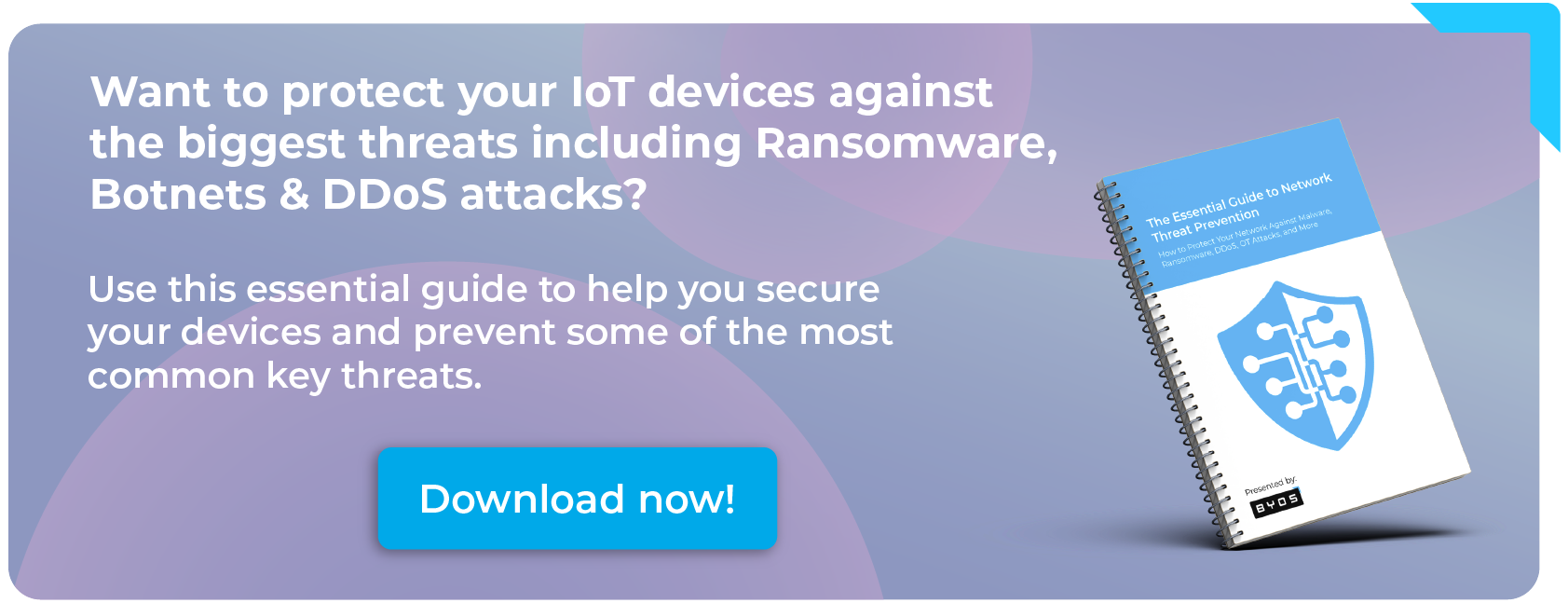Network Threats: How to Detect and Prevent the 5 Most Common Attacks

Cyberattacks are happening more often and becoming increasingly sophisticated in today’s landscape, so security teams need to work even harder to protect their networks from bad actors. Let’s look at the most common network threats and study the best techniques for detecting, preventing, and mitigating them.
Jump to a section…
While Zero Trust is often discussed as a one-size-fits-all solution to all of the above, it may not be quite the cure-all it's made out to be. In fact, Gartner published a study saying that more than half of zero trust initiatives will fail. Learn more about the potential problems with zero trust in this webinar:
Ready to learn how Byos helps organizations detect and prevent common network attacks through edge microsegmentation? Contact us today.
Denial-of-Service Attacks
DoS attacks prevent authorized users from accessing devices or networks. Attackers use strategies like traffic flooding and crashing services to execute these attacks. DDoS attacks are harder to trace because they come from multiple sources. They disrupt organizations, especially government, manufacturing, and financial institutions, causing significant damage. Here's a four-step framework to detect and prevent DoS attacks:
- Secure your infrastructure: Reduce your attack surface using an overlay network, microsegmentation, and block all communication to devices until trust with outside entities has been established with high confidence.
- Audit network vulnerability: Understanding your network and device weaknesses (before an attacker does) helps you defend your network.
- Create a response plan: Careful advance planning ensures everyone on your team knows how to respond, escalate, and resolve attacks if or when they occur.
- Know the signs: The most common warning signs of DoS attacks are slow network performance or unavailable websites. Performance monitoring systems can help. Carriers also provide service to detect and alert for DoS.
To learn more about DoS attacks and the framework for dealing with them, read our in-depth article: “Denial-of-Service Attack Prevention: The Definitive Guide.”
Back to topMan-in-the-Middle Attacks
Man-in-the-middle (MITM) attacks occur when malicious actors exploit data transmission between parties, intercepting or altering information. These attacks can have severe consequences. Various types of MITM attacks exist, including router, HTTPS and IP spoofing, email phishing, ARP cache poisoning, and inside man attacks. Here are five measures security teams can take to detect and prevent MITM attacks:
- Edge protection: Applying microsegmentation at the edge puts devices/users in a protected environment isolated from attacks.
- Secure connections: Implement policies and protections that ensure your employees are safely accessing proper internet resources (DNSSec, http/ssl, endpoint protection). For IoT/OT, isolating devices and making the undiscoverable and inaccessible keeps attackers from gaining a foothold into your network.
- Secure Authentication with multi-factor authentication: The best practices today include passwordless authentication, hardware-based validation (like FIDO2) and biometrics.
- Network monitoring: Uncommon network activity should raise flags about potential attacks. MDR/xDR/MSSP solutions provide detection and response.
- Consistent patching & updates: Executing system updates eliminate unnecessary vulnerabilities and risk.
To learn more about detecting and mitigating these types of network security threats, check out our guide on “How to Prevent a Man-in-the-Middle Attack.”
Back to topRogue Access Points
A wireless access point that an organization’s security team doesn’t know is plugged into the network is called a rogue access point. Rogue access points can range from employees’ personal routers to wireless cards jutting out of servers and devices attached to firewalls. Although rogue access points aren’t always malicious, they increase the size of the attack surface that security teams must defend, without benefiting from any of the network’s security features, monitoring, etc. Here are 4 ways security teams can protect against rogue access point proliferation:
- Physical network security: Regularly sweep your warehouses, loading areas, and other physical spaces, keeping an eye out for suspicious equipment or devices.
- Prevent direct connections: Use hardware-based microsegmentation to prevent users from connecting directly to rogue access points.
- Intrusion detection and prevention: These systems scan to discover active network connections, determining the validity and connection status of each access point.
- Create security policies: Employees can often install rogue access points for legitimate work reasons. Train your employees on company security policies to avoid that mistake.
To learn more about eliminating rogue access points and creating policies to protect your employees, read our post: “How to Protect Against Rogue Access Points on Wi-Fi.”
Back to topMalware Attacks
Malware is the software that attackers use to disrupt, damage, or exploit a network or endpoint. Using malware, attackers can steal or destroy valuable information, encrypt data, spam or spy on legitimate users, take over a system or change how that system works. Attackers can steal valuable information, encrypt data, spy on users, take control of systems, or manipulate their functionality. Ransomware attacks, in particular, have surged in recent years, with 493 million estimated in 2022. Here are seven best practices for protecting against malware, including ransomware:
- Deploy Microsegmentation: Microsegmentation solutions reduce the broader network into individually protected and controlled microsegments — significantly reducing the ability of attackers to move laterally as a means of deepening their foothold post-compromise. These solutions give security teams direct line of sight into and control over network endpoints, allowing them to detect a compromised endpoint early and lock it down remotely.
- Initial access: Preventing initial access is the most critical aspect of securing your enterprise, as you are to keep attacks from happening before they start. Each time an organization prevents an attacker from gaining access to an application, a device, or a user’s network credentials, they increase the likelihood a malicious actor will cease their attack. Attackers use known vulnerabilities, “zero-days” techniques, and tools to gain initial access various layers - a multi-layered security approach that includes microsegmentation, intrusion prevention systems (IPS), and Zero Trust frameworks works best to prevent unauthorized initial access to the network.
- Cyber monitoring and analytics: To ensure they can stop an attack as soon as possible, security teams should incorporate a SIEM (security information and event management) solution outfitted with UEBA (user and entity behavior analytics). These cyber monitoring and analytics tools comb through vast qualities of activity data across your entire organization to quickly surface threats.
- Identity management: Supplying precision control of company resource access, identity management solutions can prevent attackers from gaining deeper system access during the compromise phase.
- User awareness training: In addition to training employees to identify the warning signs of common cyber threats, empower and encourage them to report suspicious activity. It is important to note however, that even with training efforts, employees are susceptible to mistakes and hackers are getting more creative with AI and other new tools.
- Shadow IT: Make sure all your software, systems, and browsers are updated to the latest versions, and remove unused or unsupported software. The key is to be monitoring and aware of the devices on the network, as unmanaged or unknown devices may not be updated and thus vulnerable.
- Create layered defense: Use antivirus, anti-malware, anti-ransomware, EDR/MDR, and other anti-exploit solutions to build out your multi-layer security stack. Ensure the solutions used are complimentary and compatible to each other to best create a comprehensive multi-component shield.
To learn more about dealing with these types of network threats, read our article all about “How to Prevent Malware Attacks.”
Back to topEnterprise Malware
At the enterprise level, defending against malware, ransomware, phishing and other threats necessitates a multi-component solution. To achieve true comprehensiveness, an enterprise malware protection system must cover at least six of the seven stages of the cyber kill chain: reconnaissance, intrusion, exploitation, privilege escalation, lateral movement, command and control, and actions on objectives. By fortifying each stage, organizations can create a formidable shield against the ever-evolving landscape of cyber threats.
Endpoint Protection Solutions
These solutions are designed to deal specifically with the compromise stages of the cyber kill chain: intrusion, exploitation, and privilege escalation.
- Identity and Access Management: IAM oversees the relationship between users and the resources they access. Pairing IAM with access controls to edge-protected assets insures least privilege enforcement of your network.
- Edge protection: Perimeter security, such as firewalls, VPNs, and segmentation, has proven to be insufficient to protect against modern day attacks. Edge security isolates devices from attacks so that even when a firewall has been bypassed or an endpoint has been compromised, an additional layer of protection is in place.
- Detection and response (EDR/MDR/XDR): EDR uses historical threat intelligence and analytics to discover suspicious activity, investigate alerts, and investigate root cause of compromises. MDR outsources the detection and incident response workload. XDR adds machine learning and automation technology to accelerate the data analysis phase.
- Cyber monitoring and analytics: Security information and event management (SIEM) and user and entity behavior analytics (UEBA) tools are designed to find and stop in-progress cyberattacks as quickly and efficiently as possible.
- Vulnerability management: Vulnerability management tools are designed to identify and remedy known endpoint weaknesses. Inventory, analysis, mapping, and risk assessment tools enable security teams to identify vulnerabilities before attackers can exploit them.
Compromise Containment Solutions
These solutions are designed to deal specifically with the post-compromise stages of the cyber kill chain: lateral movement, command and control, and actions on objectives or exfiltration.
- Microsegmentation: Dividing a network into granular subnetworks dramatically reduces the attack surface, so if a breach does occur its ability to spread through the network will be critically limited. Research by VMware Carbon Black has shown that malicious actors use lateral movement in 70% of cyber attacks, making the technique a fundamental part of mitigating the damage post-compromise. Microsegmentation isolates your network and devices so that even if a compromised asset accesses your network, the threat actor cannot gain access to the device to which they are connected, move beyond the specific asset to which they have permission.
- Edge protection: Edge security isolates devices from attacks so that even when a firewall has been bypassed or an endpoint has been compromised, there will be an additional layer of protection to prevent the other devices in the network from being compromised. This isolation at the edge means that essentially any proliferation of ransomware or malware gets stopped at the edge.
- Web access protection: Secure web gateways (SWGs) protect users’ web access with usage policies, content blocking, and threat protection. Cloud access security brokers (CASBs) are specialized SWG tools designed to help security teams better protect users when they interact with cloud services.
To learn more about protecting your enterprise network from malware and other network threats, read our post on “Enterprise Malware Protection: How to Build the Ideal Security Stack.” and "Most Useful and Effective Security Vendors”.
Back to top
The Byos Secure Gateway Edge uses edge microsegmentation and hardware-enforced isolation to maximize the defensibility of each endpoint in your network, at each point of the cyber kill chain. Affording features like lateral movement prevention, ransomware killswitch, and protection from exploits often found on Wi-Fi networks outside IT’s control such as through rogue access points, the Byos Secure Gateway Edge is a comprehensive containment solution for the rampant spread of malware within today’s networks.
Looking to learn more? Chat with us here.


